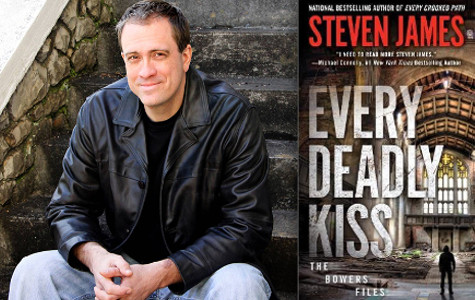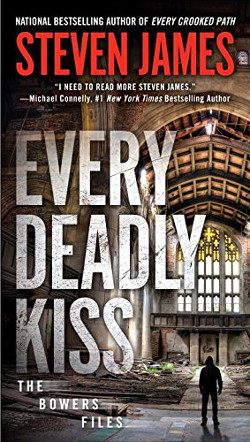
My books include multiple twists, and I’m often asked if I outline them first. The answer is an unequivocal no. Every time I try to outline even a single scene, I end up with something completely different than what I’d anticipated.
Instead of planning out how the story will go, I use a technique called organic writing—that is, I don’t work based on an outline. Instead, when I am writing, I ask myself four questions and use those to help figure out the story’s progression:
- “What would this character naturally do?”
- “How can I make things worse?”
- “How can I include a twist?”
- “What promises have I made as a writer that I have not yet kept?”

How does this all work in an actual scene? When I was writing my latest book, Every Deadly Kiss, I knew that the story would revolve around a series of murders where the bodies were left in abandoned homes in Detroit. So I decided that I needed a scene where a character discovers a body. I suppose you could say that was my outline, but as you’ll read, things didn’t quite go the way I planned.
So I began the scene with two teenagers outside an old abandoned home in Detroit. Canyon says to his friend, “So, do you have the pills?”
Then, Erik pulls out a bottle and says, “Yeah, my mom never counts ’em.”
“Will there be enough for the girls too?” Canyon asks.
“There’s plenty for all of us.”
I know these two guys are going to meet their girlfriends here in this home, but I didn’t know yet how it would play out. However, I knew that they couldn’t just walk in and find a body. Why not? Because that’s what readers would expect, and I needed to twist the scene into a direction they wouldn’t anticipate.
The two boys walk inside and don’t see the girls, but they do find symbols of pentagrams, upside-down crosses, and goat heads drawn on the wall. Erik says, “I’ve heard about this neighborhood. We should go. We should find the girls and get out of here.”
“You’re being a pussy,” Canyon says.
At this point, I still had no idea where the girls were—if they were in the house, if they were dead. So I asked myself, “What would the guys do next?”
Well, naturally, they would text or call the girls to see where they were. In order to make things worse, I didn’t want them to get in touch with the girls right away. So when they call Gwen, her phone rings but is sitting on the table.
“Something’s wrong,” Canyon says. Then, he pulls out an automatic knife that he carries, and the boys hear muffled sounds coming from the basement.
As I wrote, I was wondering what had happened to the girls. Asking myself what the boys would naturally do and how to escalate the tension, I had them approach the basement steps. When they descend, they find one girl lying on her back on the ground with candles surrounding her. She looks like she might be asleep, fresh lipstick on her lips. The second girl is seated with her back against a support beam, hands tied behind it, gag in her mouth.
Now, I was really intrigued. I wanted to know if there was a killer in the house, if the girl on the floor was dead or not, and how I could pivot the story forward while tightening the suspense.
“Give me the knife,” Erik says. “I’ll cut her free. You go see if Gwen’s okay.”
Knife in hand, he rushes over and pulls the gag from the girl’s mouth.
“Hurry,” she gasps. “Get me out of here before he comes back!”
Erik frantically saws at the rope, trying not to cut her wrist as he does. I wondered if maybe he did cut her wrist accidentally, but I put that thought aside momentarily. I had him glance over and watch as his buddy tries futilely to wake Gwen up.
Finally, he gets the girl free and helps her to her feet. She looks past his shoulder and cries out, “He’s right behind you!”
Erik spins around—
So who’s there? Is it a killer? If it is, then all of these kids would probably be in mortal danger, and I didn’t think that would help the story’s progression. So instead, Canyon leaps forward and shouts, “Gotcha!”
The girls start laughing. Gwen says to Erik, “Man, that was awesome, you should’ve seen your face.”
But then I paused.
If that’s how the scene ended, it wouldn’t be satisfying to readers. Sure, it might’ve been unexpected—you might even call it a twist—but it didn’t escalate anything. There wasn’t any emotional payoff. It felt like a letdown. So when I asked how I could make things worse, I thought, What if Erik is still holding the knife?
And he was.
When his buddy leaped forward, Erik was grasping the knife, and now it’s embedded all the way to the hilt in his friend’s stomach.
Erik, trying to fix things, draws the knife back out. Canyon drops to the ground with his shirt soaking with blood. The girls start screaming, and Erik fumbles with his phone to call 911.
Now, as you can see, the scene did not end at all like I thought it would. The boys don’t even find a body in the house! I didn’t know whether or not Canyon survived that scene, but at least now I was ready to go on with my next chapter. The story was intriguing, had a little bit of a twist to it, and made a number of promises that could be fleshed out and fulfilled later in the book.
Scene by scene, this is how a story unfolds for an organic writer. Question by question, the book grows, and there are just as many surprises for the author as there are for the readers. And this is why, rather than trying to lay things out beforehand, I love to let stories emerge organically as I write them.
Read an excerpt from Every Deadly Kiss!
To learn more or order a copy, visit:
opens in a new window![]() opens in a new window
opens in a new window![]()
Steven James is a critically-acclaimed crime writer. His latest suspense thriller, Every Deadly Kiss, releases on July 4th. For more information about his books, click to www.stevenjames.net.

I really enjoyed your explaination of “organic writing” and how to develope a story.
Author, thanks for the cool content about organic writing. Indeed, to learn how to make a text so that the text “sells” takes a lot of skills and effort. Always inspired as professionals in Australia do when you pay them for an essay or the professional journalist write their news or whole reports. There are few worthy and professional writers and I was lucky to come across https://essayontime.com.au/homework-help-in-australia to understand. I was still in college at that time, and thanks to their skills, I received wonderful works written with just such a text that “sells”. This is a note to all future journalists.
Thanks for sharing!